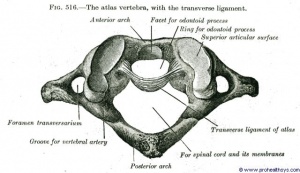Transverse Ligament Stress Test: Difference between revisions
Kai A. Sigel (talk | contribs) (Replcaed two videos on the transverse ligament test with one video of better audiovisual quality) |
No edit summary |
||
| Line 26: | Line 26: | ||
*#Lump sensation in the throat | *#Lump sensation in the throat | ||
{{#ev:youtube| | {{#ev:youtube|GN-yvAYFIig|300}} | ||
{{#ev:youtube|Ljkd_q-apbU|300}} | |||
== Evidence == | == Evidence == | ||
| Line 36: | Line 38: | ||
Pettman E: Stress tests of the craniovertebral joints. In: Boyling, JD, Palastanga N, eds. ''Grieve's Modern Manual Therapy: The Vertebral Column'', 2nd edn. Edinburgh: Churchill Lingstone, 1994:529-538. | Pettman E: Stress tests of the craniovertebral joints. In: Boyling, JD, Palastanga N, eds. ''Grieve's Modern Manual Therapy: The Vertebral Column'', 2nd edn. Edinburgh: Churchill Lingstone, 1994:529-538. | ||
== References == | == References == | ||
Revision as of 12:13, 18 June 2019
Original Editor - Tamara Eller and Audrey Pittman
Top Contributors - Tamara Eller, Audrey Pittman, Admin, Vidya Acharya, Rachael Lowe, Kim Jackson, Evan Thomas, Tony Lowe, Kai A. Sigel, WikiSysop and Anas Mohamed
Purpose[edit | edit source]
Test for hypermobility of the atlantoaxial articulation
Technique [1][edit | edit source]
- The patient is placed in a supine postion with the Therapist supporting the patient's head with the palms and 3rd-5th fingers.
- The Therapist then places the index fingers between the occiput and spinous process of C2, so the index fingers are over the neural arch of the C1 vetebra.
- The Therapist then lifts the patients head and C1 vetebra anteriorly, without allowing flexion or extension.
- The position should be held for 10-20 seconds.
- A positive test is the recurrence of symptoms:
- Abnormal pupil response
- Eye twitching or nystagmus
- Soft end feel
- Muscle spasm
- Dizziness
- Nausea
- Paresthesia of the lip face or limb
- Lump sensation in the throat
Evidence[edit | edit source]
Provide the evidence for this technique here
Resources[edit | edit source]
Pettman E: Stress tests of the craniovertebral joints. In: Boyling, JD, Palastanga N, eds. Grieve's Modern Manual Therapy: The Vertebral Column, 2nd edn. Edinburgh: Churchill Lingstone, 1994:529-538.
References[edit | edit source]
- ↑ ↑ Dutton, M. (2008). Orthopaedic: Examination, evaluation, and intervention (2nd ed.). New York: The McGraw-Hill Companies, Inc.







